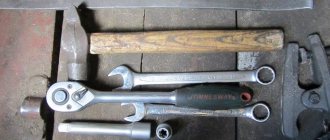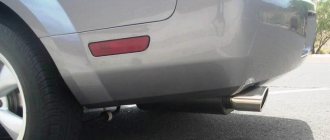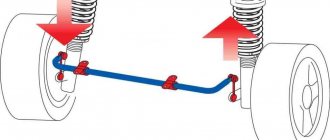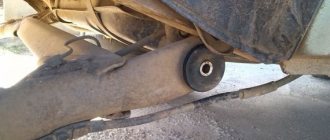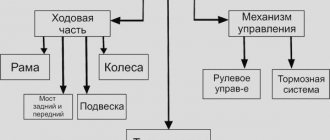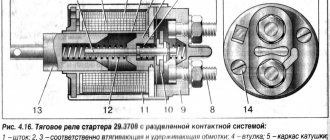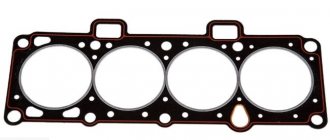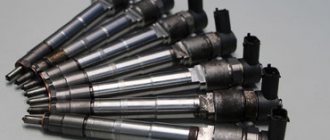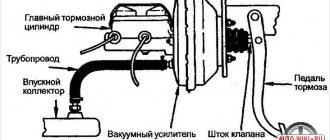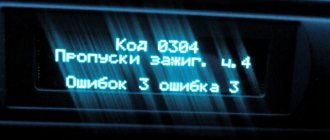The suspension is one of the most important components of a vehicle. Its condition must be constantly monitored, because the breakdown of even the smallest suspension element can become a huge problem. The ball joint is one of the small but extremely necessary suspension parts. Like all elements of a vehicle, sometimes it needs to be replaced. Undoubtedly, you can resort to the help of professionals and replace the ball joints at a service station. However, this activity is quite doable in a garage, for which the car owner will need a little time, patience and a special puller for ball joints.
Useful tips
The service life of a support often depends on a lot of factors and on average ranges from 15 to 120 thousand kilometers. The life of a ball joint can be shortened by even a minimal crack in the boot. Water, sand and dirt can penetrate through it into the hinge. To prevent damage to the ball joint, the condition of the rubber protective boot should be monitored. It is advisable to do this on an overpass or inspection hole.
In order for ball joints to last longer, you need to drive carefully on broken road surfaces and change damaged boots in a timely manner. Do not forget that any vehicle mechanisms and components require regular maintenance and repair. You can learn more about replacing ball joints in this video.
This is interesting: How to change a Duster low beam bulb
Successful design is the key to success
So, it’s time to find out what the secret of the ball joint is, and to do this, let’s look at its design. Let's be honest - there is nothing supernatural in it, and on the contrary, it is an extremely simple mechanism.
The average ball joint of a modern car consists of the following elements:
- a rod with a spherical tip on one side and an element for fastening to the suspension arm on the other;
- cylindrical metal body;
- polymer liner;
- a pressure washer that secures the previous part in the body;
- boot - a rubber shell that ensures its tightness.
As we can see, there is nothing complicated, and the attached illustration quite clearly lets us understand how everything works.
Modern ball joints are consumables, that is, they are maintenance-free and, in the event of failure, can only be replaced.
Previously, designers took a more rational approach to these parts, and provided them with special holes through which lubricant could be pressed inside, but nowadays this is irrelevant, because thanks to the high-strength plastics used for the liners, these suspension elements can travel up to 150 thousand kilometers without any problems .
How does it work?
As you understand, a closed “ball” can rotate in any direction, even spin. A fixed mount is attached to the cylindrical body, which is installed in the necessary suspension elements - this part is not movable. But the upper threaded pin is attached to the moving parts, thanks to which they can turn or even rotate.
In old rear-wheel drive cars, for example our VAZs, there were about 3 ball joints. Two were located in the burdocks and allowed the caliper to rotate along with the wheel. One was located in the steering rod and pushed the wheels.
The MacPherson suspension design has been greatly simplified. Here, as we know, there is a support bearing on top and it allows the strut and caliper to rotate, but the ball joint remains at the bottom. There are also steering links that push the calipers, causing the wheels to turn. There are only two ball joints here.
It is also worth mentioning that there are options with four supports, but they are quite rare and should not be considered.
Many may argue that a ball joint and a tie rod are not the same thing. In fact, the differences are only in the mounting of the case, the essence of the work is the same.
If we summarize the work, the following comes out: you turn the steering wheel, the force passes through the steering rack to the caliper, and in order for it to turn, hinge joints are needed, this is exactly the work that the supports, steering tips and, of course, the support bearing do.
Classic ball design
A standard ball joint design requires the following main components:
- metal case;
- pin with ball head;
- compression spring;
- corrugated rubberized boot.
A sufficient amount of lubricant was packed inside at the factory. High-quality lubricant was enough for a long run. At each maintenance, mechanics must check the safety of the boot and the quality/volume of the lubricant, and if necessary, use a lubricant to repress the required amount. In later models, some metal products were replaced with plastic analogues. Also, there are no springs inside anymore (they got rid of them as unnecessary). The spherical head of the finger is now rolled in a hemisphere of liners. In modern models, the latter are no longer made of plastic, but of more durable and durable nylon. Manufacturers began to produce two types of ball bearings, so there are maintenance-free and maintenance-free bearings. Most new machines have a second type of assembly. There is no possibility of disassembly and there is a built-in oiler for adding lubricant. Sometimes there are intermediate types that relate to non-separable design options, but have an oiler.
Signs of a bad ball joint
You can guess that while driving, this element bears every impact of the road surface, which means that in domestic realities it experiences enormous loads. This is why it is so important that ball joints are easy to change. The reasons for the breakdown of this unit include:
- Damage to the boot . If you ignore checking this important element, you may not notice how sand and various road debris in the form of abrasive particles will begin to seep into the crack. Since the boots are made of rubber, they are especially susceptible to wear at low or, conversely, high temperatures.
- Off-road . Unfortunately, this factor is critical in our realities, which is why we have to change not only the supports, but also other elements many times more often.
- Lubrication production . It is logical that when friction occurs, it is worth adding lubricant, otherwise the unit will wear out more.
- Chatting . During operation, the liner and pin will inevitably grind down, this will increase the gap to the point that the support rod will jump out of the socket.
Considering the roads in the CIS, it is difficult to rely on the resource specified by the manufacturer.
It, in turn, depends on the liner: as a rule, such spare parts can last 150 thousand mileage or 15. For example, previously in a VAZ the service life was about 20 thousand. The good news is that the unit does not fail suddenly, allowing you to recognize worn out supports in advance. The first signs of a malfunction will appear when:
- Noise from suspension . Sounds from the front of the car can be heard even when overcoming speed bumps or potholes at 30 km/h. This may indicate either complete wear of the liner or a lack of lubrication.
- Wheel rocking . If play occurs in the unit, you may notice swaying, which is very dangerous, since during tilting there is a possibility that the wheel will turn out.
- Uneven tire wear . Occurs when wheel alignment is disrupted. The factor may indicate other suspension problems, but if it occurs, it is worth starting the check with the ball joints.
- The car pulls away while braking . As in the previous case, the symptom may indicate various suspension problems.
- Creaks . Which can occur when turning the steering wheel.
It is noteworthy that in winter, the noise of the ball joint is an acceptable phenomenon, occurring due to the fact that the lubricant has not yet had time to warm up. But if after some time the noise still does not disappear, this indicates a problem.
Self-diagnosis of supports
Methods for checking these elements vary depending on the suspension design. On most modern machines it comes in 2 varieties:
In foreign cars of the middle and highest price categories, a multi-link suspension is installed not only at the front, but also at the rear, instead of a continuous beam.
First, it’s worth figuring out how to determine if the upper ball joint of a multi-link suspension is faulty, since it’s easier to identify.
The procedure is as follows:
If the upper hinge is faulty, you will immediately feel some play, after which you can begin replacing the element .
If you don’t have enough strength to swing the wheel, then use another method: lift it with a jack and swing it by the lower and upper parts. The same technique makes it possible to identify play in the lower support in a MacPherson-type suspension, provided that it is sufficiently worn out. The best way to check the performance of the lower ball joint on any suspension is to determine the amount of play. Rocking the wheel will not show anything, because the hinge, even in a suspended state, is under load. To work, you will need a mount and an inspection ditch; the services of an assistant are not needed here.
While in the inspection ditch, carefully examine the condition of the anthers. Torn rubber and grease escaping from cracks will serve as indirect evidence of a faulty ball joint.
Using the described method, you will detect the slightest play in the hinge. This is where the problem arises, because a certain amount of clearance between the plastic and the metal is built into the part from the factory. Focus on the amplitude of movement of 3 mm; if the play is noticeably greater, then it is better to change the ball joint.
Diagnostics and replacement
If, when directly turning the steering wheel of a vehicle, the motorist needs to make special efforts or a characteristic creaking occurs, then most likely there are problems with the ball joint. In addition, this will also be indicated by the occurrence of a knocking sound when the car is moving at low speeds on uneven surfaces. Another sign of failure of ball bearings is wobbling and instability of the front wheels when moving directly in a straight line. Another sign of this problem is uneven wear on the vehicle's tires.
It is quite clear that a quick and high-quality replacement of the entire ball joint device will be possible only with the help and operation of professionals. However, many car enthusiasts prefer their own labor and work. In the modern world, the question of the production of ball joints finds its answer in the thesis that this is a high-tech process that allows us to achieve a high degree of reliability and durability. However, replacing this device is one of the most common types of car repairs. The situation, of course, can in no way change until the quality of our domestic roads changes.
This is interesting: How to change the clutch on a VAZ 2110
Checking the product.
Before replacing ball joints on a Chevrolet Niva, you need to inspect their appearance for damage. Typically, such an assessment is carried out by specialists at a service station. But this cannot always guarantee a good result; in addition, this method is quite expensive. When inspecting yourself, you must first of all pay attention to the main signs of malfunctions:
- Large gap gap
- Damage to the surface of the boot
If only the boot is out of order, and the wear is not so strong that there is a backlash, then you can only get by by replacing it. If the problem is more serious, then the owner is faced with the question of choosing a high-quality and inexpensive part. The most common options on the market are products from Kedr, Phobos and Trek. Usually the cost of the sets is the same and does not exceed 3,000 rubles.
Mounting methods
The main differences between modern spherical joints are not so much in the design as in the methods of fastening. This is due to labor-intensive costs during maintenance and replacement. The most optimal option, acceptable for the car owner, is considered to be fixing the hinge body to the suspension arm using a threaded or rivet connection. The method allows, if necessary, to quickly dismantle a worn-out unit.
Later, manufacturers began to abandon this method in favor of integrating the lever into the suspension. This design had a disadvantage, since it was necessary to change the lever assembly, even if it was not worn out. The advantage was the lightweight design. Although there is an opinion that marketers lobbied for such a system in order to increase profits from the sale of spare parts, because it is necessary to change the lever assembly. Some automakers have compromised and abandoned the rigid fixation to the lever. An alternative was a retaining ring. The support was only pressed into the lever. Examples are the Jeep Patriot or Opel Zafira C. In this case, replacement will require a press or other type of force.
Fixation on the steering knuckle
If the support is located on the lever, then it can be attached to the steering knuckle. Such features are typical for a ball-on-lever. The design can have three options:
- the threaded pin is connected and secured with a nut, which must be cottered;
- for fastening, a self-locking nut is used, which has an internal locking ring;
- a pinch bolt is installed, which is rare, for example, on the Hyundai Santa Fe since 2006.
The last point is less acceptable, since if it breaks and needs to be replaced, it may turn out that the threads have soured. A negative factor is the need for a special wedge used to release the ends of the knuckle bracket where the ball pin is fixed. Sometimes even in the wonderful suspension designs of German cars, stuck bolts create many difficulties during disassembly. The situation cannot be saved by heating the fist or freezing the bolt. Even a ten-ton force from a hydraulic press does not allow the bolt to be pressed out. Owners of an Audi A6, for example, have to part with amounts equivalent to $400-500. In some cases, engineers move the hinge to the steering knuckle from the lever. Although such a solution does not add maintainability. Then there are several ways to fix it:
- bolting;
- pressing;
- in the knuckle bracket the use of a coupling bolt.
In each case there are both advantages and disadvantages.
Tool for unscrewing the support
We will consider another type, which is used not for pressing out the finger, but for removing the support itself.
The fact is that on a number of cars (Peugeot, Citroen) the ball joint is screwed into the lever. Over time, the threaded connection sours, and it is quite difficult to unscrew this suspension element without a special tool.
But you can make the necessary puller yourself, rather than spending money on a factory one.
It is made from a 2" thick-walled pipe 8-9 cm long.
At the end of this pipe it is necessary to make 4 spikes with a width of 5 mm and a height of 7 mm, located at an angle of 90 degrees relative to each other.
That is, you should get 4 protrusions at the end of the pipe, evenly distributed around the circumference. This can be done using a hacksaw and a file, or with a grinder.
From the other end we make slits to a depth of 3 cm, dividing the circumference of the pipe into 8 parts.
Then we bend these petals to the center using a hammer, significantly reducing the diameter.
We take a 24mm nut and screw it to the end part, and then use a welding machine to seal the slots made.
It is quite convenient to work with such a puller - we put it on the support so that the spikes fit into special grooves on the support body.
In this case, the finger will pass through the manufactured tool, which will allow the locking nut to be screwed onto it, thereby securing the puller. All that remains is to use a 24mm wrench to unscrew the support using the welded nut.
Device
Technical progress has led to changes in the original design of ball joints, although they were not fundamental. The stamped halves of the body, connected by spot welding, were replaced by cast and dismountable supports - with a threaded cover, maintenance-free and serviceable - with grease fittings. These improvements were justified and useful. Today, the most common maintenance-free ball joint design consists of: a body with a spherical recess and a pin with a ball on one end and threads on the other. The boot, placed on the finger, prevents moisture and dirt from entering the housing filled with a special thick lubricant.
The main function of the ball joint is to ensure its fixed position in the horizontal plane during vertical movement of the wheel. The ball pin can rotate in the body, swinging at small angles. That is, in the plane of its attachment, the ball joint provides simultaneous rotational and linear (limited) movements of the finger.
All parts of the ball joint are usually made of steel. To reduce friction of contacting working surfaces, the spherical recess of the housing is covered with plastic or other polymer material. However, there are ball joints that do not include a polymer coating between the body and the pin. This applies, first of all, to outdated domestic cars. These models were equipped with collapsible ball joints, in which backlash was eliminated by tightening the cover.
There are two ways to attach the ball joint. In the first case, it is bolted to the lever. In the second, it is pressed into it. If a bolted ball joint fails, it can be replaced with a separate unit. To do this, you just need to buy and install it by bolting it to the lever. In the second case, you will have to change the suspension arm with a pre-installed, pressed-in ball joint. The cost of such repairs is much higher, since it also includes the cost of the lever.
Press-fitted ball joints are typically installed on Japanese-made vehicles. Asian manufacturers of auto parts offer consumers ball joints for such cars in the form of separate units. This is much cheaper, but you should be aware that their quality is significantly inferior to the original, and the lever will have to be remade in a “makeshift way”, turning it into a part that is not subject to warranty repair
